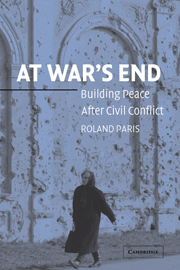Book contents
- Frontmatter
- Contents
- List of Figures
- Preface
- Introduction
- PART I FOUNDATIONS
- PART II THE PEACEBUILDING RECORD
- 3 Introduction to the Case Studies
- 4 Angola and Rwanda: The Perils of Political Liberalization
- 5 Cambodia and Liberia: Democracy Diverted
- 6 Bosnia and Croatia: Reinforcing Ethnic Divisions
- 7 Nicaragua, El Salvador, and Guatemala: Reproducing the Sources of Conflict
- 8 Namibia and Mozambique: Success Stories in Southern Africa?
- PART III PROBLEMS AND SOLUTIONS
- Conclusion
- Bibliography
- Index
7 - Nicaragua, El Salvador, and Guatemala: Reproducing the Sources of Conflict
Published online by Cambridge University Press: 05 September 2012
- Frontmatter
- Contents
- List of Figures
- Preface
- Introduction
- PART I FOUNDATIONS
- PART II THE PEACEBUILDING RECORD
- 3 Introduction to the Case Studies
- 4 Angola and Rwanda: The Perils of Political Liberalization
- 5 Cambodia and Liberia: Democracy Diverted
- 6 Bosnia and Croatia: Reinforcing Ethnic Divisions
- 7 Nicaragua, El Salvador, and Guatemala: Reproducing the Sources of Conflict
- 8 Namibia and Mozambique: Success Stories in Southern Africa?
- PART III PROBLEMS AND SOLUTIONS
- Conclusion
- Bibliography
- Index
Summary
Central America has historically suffered from chronic civil violence, insurgencies, coups, and military dictatorships. During the latter stages of the Cold War, armed revolutionary movements sought to overthrow the governments of Nicaragua, El Salvador, and Guatemala. In Nicaragua, a group of dissidents backed by the United States and known as Contras fought an insurgency campaign against the left-leaning Sandinista government in Managua throughout the 1980s. In El Salvador, the Farabundo Martí Liberation Front (FLMN) launched a guerrilla war against the government in 1981 that cost an estimated seventy-five thousand lives and displaced roughly one-quarter of the country's population. In Guatemala, when revolutionary movements challenged the military government in the late 1970s and early 1980s, the Guatemalan regime responded with a brutal counterinsurgency effort that lasted into the early 1990s, mainly targeting indigenous Mayan communities in which many revolutionaries, including the major rebel group, the Guatemalan National Revolutionary Unity (URNG), were based.
Central American leaders met on several occasions during the 1980s to discuss possible solutions to these conflicts. At one such meeting – on August 7, 1987 in Esquipulas, Guatemala – the presidents of Guatemala, El Salvador, Honduras, Nicaragua, and Costa Rica formally endorsed a peace plan presented by the Costa Rican president, Oscar Arias, which called for a cease-fire, national reconciliation, amnesty, democratization, termination of external aid to insurgent movements, and free elections.
- Type
- Chapter
- Information
- At War's EndBuilding Peace after Civil Conflict, pp. 112 - 134Publisher: Cambridge University PressPrint publication year: 2004



